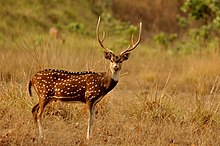
Spotted deer

The chital (/tʃiːtəl/) or cheetal (Axis axis), also known as spotted deer or axis deer, is a species of deer that is native in the Indian subcontinent. The species was first described by German naturalist Johann Christian Polycarp Erxleben in 1777. A moderate-sized deer, male chital reach nearly 90 cm (35 in) and females 70 cm (28 in) at the shoulder. While males weigh 30–75 kg (66–165 lb), the lighter females weigh 25–45 kg (55–99 lb). The species is sexually dimorphic; males are larger than females, and antlers are present only on males. The upper parts are golden to rufous, completely covered in white spots. The abdomen, rump, throat, insides of legs, ears, and tail are all white. The antlers, three-pronged, are nearly 1 m (3.3 ft) long. The scientific name of the chital is Axis axis. 'Axis' has several possible origins: the Greek axōn, the Lithuanian ašis, or the Sanskrit akṣaḥ. The vernacular name chital is derived from the Hindi cītal or from the Sanskrit citrala, both of which mean 'variegated', in reference to the spotted coat of the deer. Another possible origin is from the Sanskrit citra, which means 'bright' or 'spotted'. The name of the cheetah has a similar origin. Other names for the chital are cheetal, cheetul, Indian spotted deer or simply the spotted deer, and axis deer. The chital is the sole member of the genus Axis and is classified under the family Cervidae (deer). The species was first described by German naturalist Johann Christian Polycarp Erxleben in 1777. Earlier, Hyelaphus – comprising the Bawean deer (H. kuhli), the Calamian deer (H. calamianensis ), and the hog deer (H. porcinus) – was considered a subgenus of Axis. However Hyelaphus has now been elevated to generic status a 2004 phylogenetic study showed that Hyelaphus is closer to the genus Rusa than Axis. The study showed that Axis is paraphyletic, and distant from Hyelaphus in the phylogenetic tree. The chital forms a clade with Rucervus duvaucelii (barasinga) and R. schomburgki (Schomburgk's deer). The chital diverged from the Rucervus lineage in the early Pliocene (five million years ago). A 2002 study shows that Axis shansius, followed by A. lyra, is the earliest ancestor in the A. axis lineage. Axis is no longer considered a subgenus of Cervus. The species is considered monotypic. A 1951 paper identified two subspecies of the chital: A. a. axis and A. a. ceylonensis (Sri Lankan axis deer). The validity of these, however, is disputed. The chital is a moderately sized deer. Males reach nearly 90 cm (35 in) and females 70 cm (28 in) at the shoulder; the head-and-body length is around 1.7 m (5.6 ft). While immature males weigh 30–75 kg (66–165 lb), the lighter females weigh 25–45 kg (55–99 lb). Mature males can weigh up to 98 to 110 kg (216 to 243 lb). The tail, 20 cm (7.9 in) long, is marked by a dark stripe that stretches along its length. The species is sexually dimorphic; males are larger than females, and antlers are present only on males. The dorsal (upper) parts are golden to rufous, completely covered in white spots. The abdomen, rump, throat, insides of legs, ears, and tail are all white. A conspicuous black stripe runs along the spine (back bone). Chital have well-developed preorbital glands (near the eyes) which have stiff hairs. They also have well-developed metatarsal glands and pedal glands located in their hind legs. The preorbital glands, larger in males than in females, are frequently opened in response to certain stimuli. Each of the antlers has three lines on it. The brow tine (the first division in the antler) is roughly perpendicular to the beam (the central stalk of the antler). The antlers, three-pronged, are nearly 1 m (3.3 ft) long. Antlers, as in most other cervids, are shed annually. The antlers emerge as soft tissues (known as velvet antlers) and progressively harden into bony structures (known as hard antlers), following mineralisation and blockage of blood vessels in the tissue, from the tip to the base. A study of the mineral composition of the antlers of captive barasinga, chital, and hog deer showed that the antlers of the deer are very similar. The mineral content of the chital's antlers was determined to be (per kg): 6.1 milligrams (0.00022 oz) copper, 8.04 milligrams (0.000284 oz) cobalt, and 32.14 milligrams (0.001134 oz) zinc. Hooves measure between 4.1 and 6.1 cm (1.6 and 2.4 in) in length; hooves of the fore legs are longer than those of the hind legs. The toes taper to a point. The dental formula is 0.1.3.33.1.3.3, same as the elk. The milk canine, nearly 1 cm (0.39 in) long, falls off before one year of age, but is not replaced by a permanent tooth as in other cervids.
